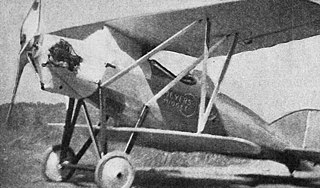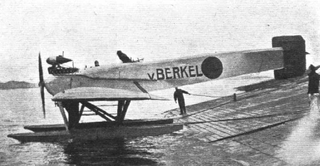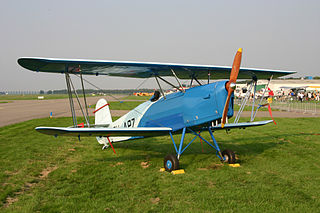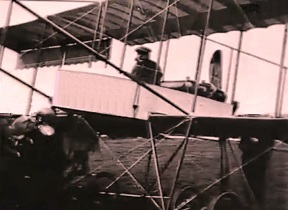
The Fokker D.IX was a Dutch single seat, single engine fighter aircraft, the final, more powerful evolution of the Fokker D.VII World War I success, flown in 1921. The sole example was purchased by the US Army Air Service but not developed further.

The Meyers Midget was a one-off small, low-powered, sporting single-seat sesquiplane, designed and built in the United States in 1926, incorporating several innovative structural features.

The FVM Ö 1 Tummelisa is a single seat, single engine Swedish biplane from the 1920s. It was operated by the Swedish Air Force as its advanced trainer until the mid-1930s.
The Spijker V.3, sometimes anglicized to Spyker V.3 or Spyker-Trompenburg V.3, was a Dutch single-engine, single-seat biplane fighter, designed and built just before the end of World War I.

The Spijker, Spyker V.1 or Spyker-Trompenburg V.1, was a single seat biplane fighter built in the Netherlands during World War I. It was underpowered and did not go into production.

The Van Berkel W-B was a single engine Dutch long range reconnaissance seaplane built in the early 1920s for work in the Dutch East Indies. Six were operated by the Dutch Naval Aviation Service (MLD) with disappointing results, though the last two were not decommissioned until 1933.

The Pander E was the first indigenous Dutch training aircraft, used by clubs and also privately owned. A two-seat, single-engine biplane, 17 were built in the Netherlands from 1926 with engines of increasing power.
The Koolhoven F.K.45 was an aerobatic biplane built to the requirements of one pilot who flew it at airshows in the mid-1930s. Only one was built.
The NVI F.K.29 was a small Dutch biplane transport, carrying two passengers who boarded after the nose, with its single engine and fuselage, had been swung open. It was intended to link small local fields to main airports.

The NVI F.K.32 was a tandem two-seat biplane training aircraft designed and built in the Netherlands in the mid-1920s. It did not go into service.

The NVI F.K.34 was a three-seat reconnaissance floatplane built in the Netherlands in 1925 as a private venture in the hope of a Dutch Naval Aviation Service order; two accidents during testing meant that it did not go into production.

The Lambach HL.II was a single seat aerobatic biplane designed and built in the Netherlands to provide Dutch pilots in a local, annual competition with their own machine. It proved no match for contemporary Germany aircraft.

The Koolhoven Heidevogel was one of the first Dutch aircraft, an improvement of the popular Farman type.

The Van Meel Brikken was an early Dutch Farman type biplane. Three were built, one being the first Dutch military aircraft and another the first Dutch water-borne one. Two were used by the Dutch Army Aircraft Division as trainers.
The Caudron C.251 Et-2 was a French tandem seat, open cockpit biplane designed as an intermediate trainer and built in 1931. It did not go into production.

The Caudron C.33 "Landaulet Monsieur-Madame" was a French twin engined biplane with four seats, two in open cockpits and two in an enclosed cabin.

The Heinkel HD 20 was a twin engine, three seat German biplane built in 1926 for civil survey work.

The VIH Holland H.1 was a Dutch two seat, low-powered biplane. Only one was built.

The Thulin E was a Swedish reconnaissance aircraft built in the late 1910s.

The Thulin FA was a Swedish reconnaissance aircraft built in the late 1910s.

















